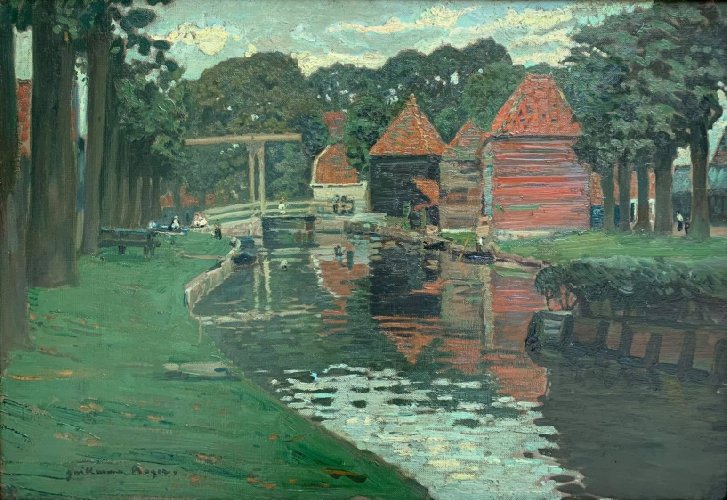Description:
Georges Guillaume Roger (1867-1943) was a French painter. He studied in Paris under Jean-Léon Gérôme. He regularly exhibited his works at the Paris salons. He was involved in genre painting, portraiture, but also landscapes and seascapes. He was inspired by views of Brittany and the Netherlands*.
Description of the painting:
The painting “Red House in Edam” shows a view of a part of the Dutch town lying on the canal. The foreground is occupied by a view of the reinforced channel bed and its left bank. The light reflections are depicted on the water surface with short, distinct brush strokes. The right and left parts of the canal contrast with each other through a combination of dark and light tones, depicting the shadow and the sky reflecting in it. The edge is covered with a flat-treated grass. The second plan is filled with figures and architecture. The right part is occupied by characteristic Dutch houses located at the very edge of the canal, which serves as a communication route. This is emphasized by the figure of a man in a boat. The edges are connected by a wooden drawbridge, over which the inhabitants stroll, looking at the water. The left bank seems to be a recreational area, where the figures look like they are spending time by the water. You can also distinguish the third plan, which is formed by tree crowns that almost close the picture.
The artist uses Impressionist solutions. This is emphasized by both the technique of execution – the way paint is applied, and the subject chosen by the artist – the frame of a fleeting moment. However, the painting is kept in a muted palette, with dominant green. It seems as if the frame of the view were the massive, tall trees growing along the edge. The tree crowns in the third plan form an extension of it. The viewer’s eye is attracted by the houses, especially the titular red house, which is a distinctive color accent. The distortion of proportions is intriguing – the trees and architecture overwhelm the scenery with their enormity. The effects used by the artist – muted palette, synthesis of form or distortion of proportions – bring the painting closer to post-Impressionist works with a symbolic meaning.


